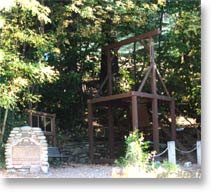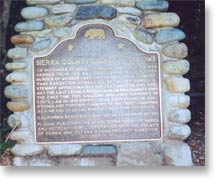|

The
Washoe and Maidu Indians lived peacefully in the
area before gold was discovered 100 years ago in
November,1849 on the North Fork Yuba River.
It was a direct result of the
discovery and continuous search for gold in
California, that the development of Sierra County
began. As the roads improved, people began to
travel to the more primitive environment to enjoy
the beauty and wildlife. In the 1800's a surge of
interest arose from the city people for recreation
and relaxation as a temporary relief from the
frantic pace of urban life. Sierra County was
founded in 1852. By 1926 many popular resorts had
been constructed for the purpose of fishing,
swimming, boating and lodging. Bassett's Station
was built over 125 years ago at the intersection of
Hwy. 49 and Gold Lake Road to provide a rest stop
and supply point for travelers.
 Downieville
was named for Major Wm. Downie, leader of the first
gold discovery party in Sierra County. Founded in
1849 as a gold mining town, and now the County seat
of Sierra County. By May 1850 Downeiville had 15
hotels and gambling houses, 4 bakeries and 4
butcher shops. By the mid 1850's Downieville was
California's 5th largest town. Downieville
was named for Major Wm. Downie, leader of the first
gold discovery party in Sierra County. Founded in
1849 as a gold mining town, and now the County seat
of Sierra County. By May 1850 Downeiville had 15
hotels and gambling houses, 4 bakeries and 4
butcher shops. By the mid 1850's Downieville was
California's 5th largest town.
Sierra City was established
as a mining town in 1850. By 1852 Sierra City had 2
large buildings, a bakery shop and several gambling
houses and saloons. Miners were busy retrieving
gold from several tunnels in the nearby Sierra
Buttes. In the winter of 1853 many buildings were
crushed by an avalanche of snow, forcing the
inhabitants to rebuild at the present lower
elevation.
The Sierra Valley ranches,
settled in the 1850's consist of the communities of
Sattley, Sierraville, Calpine and Loyalton. They
provided dairy products, hay and cattle for the
Western Sierra County mines and the Comstock Mines
in the 1860's. One of the finest agricultural
regions in California in the 1880's.
Originally known as Smith's
Neck the name was changed to Loyalton because of
the sentiment of loyalty to the Union cause during
the Civil War in 1863. In 1901 Loyalton was
incorporated as a dry town, the size was set at
50.6 square miles. It was the second largest city
in California.

|



 Downieville
was named for Major Wm. Downie, leader of the first
gold discovery party in Sierra County. Founded in
1849 as a gold mining town, and now the County seat
of Sierra County. By May 1850 Downeiville had 15
hotels and gambling houses, 4 bakeries and 4
butcher shops. By the mid 1850's Downieville was
California's 5th largest town.
Downieville
was named for Major Wm. Downie, leader of the first
gold discovery party in Sierra County. Founded in
1849 as a gold mining town, and now the County seat
of Sierra County. By May 1850 Downeiville had 15
hotels and gambling houses, 4 bakeries and 4
butcher shops. By the mid 1850's Downieville was
California's 5th largest town. 
